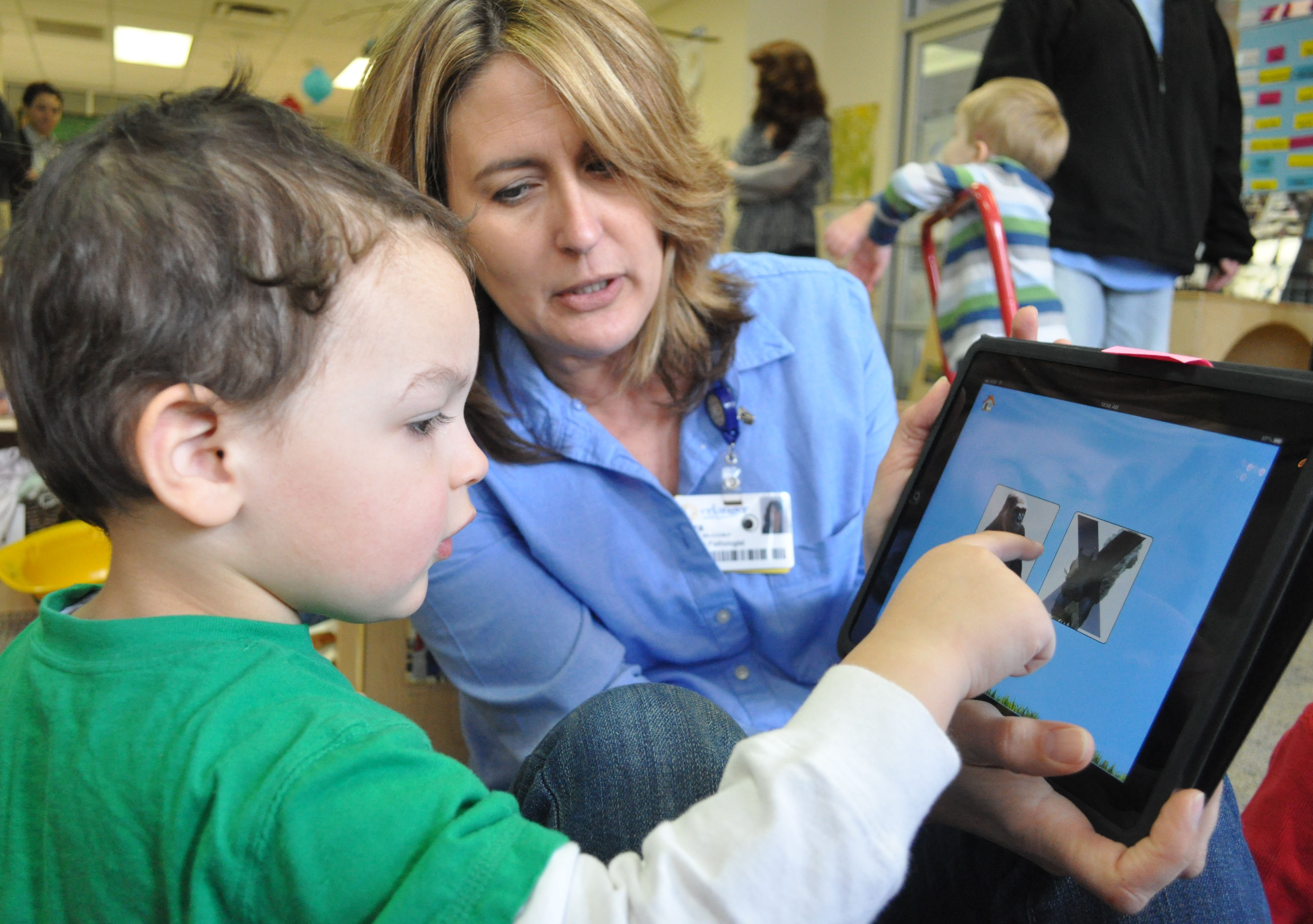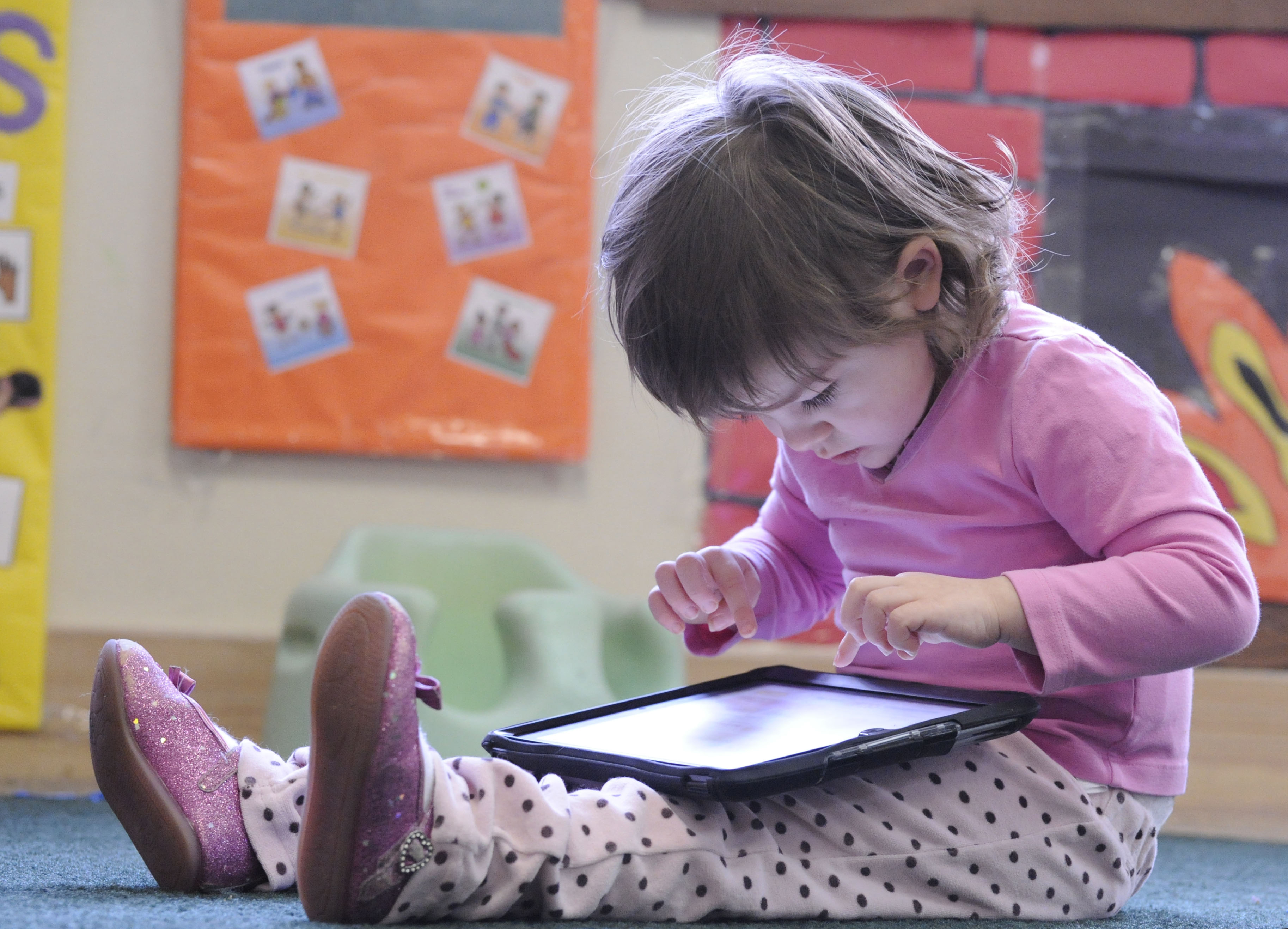IPads help Chattanooga students with autism communicate
Friday, January 1, 1904
 Speech therapist, Kara Knowles helps Marlon Parks, 2, play with an iPad Wednesday morning at the Siskin Early Learning Center in Chattanooga. The Institute has integrated iPads into their curriculum because they are believed to improve social and communication skills, especially with children with autism.
Speech therapist, Kara Knowles helps Marlon Parks, 2, play with an iPad Wednesday morning at the Siskin Early Learning Center in Chattanooga. The Institute has integrated iPads into their curriculum because they are believed to improve social and communication skills, especially with children with autism.Two-and-a-half-year-old Rowan Murray used to get so frustrated she would scream and throw tantrums, even breaking her mother's nose in such a fit.
She resorted to such outbursts because communication is difficult for her because she has autism.
"She's not a mean little kid," said Rowan's mother, Meghan Murray. "She's a sweet kid. But when you're thirsty and you can't tell anybody, it's mentally frustrating."
With the arrival of an iPad at Rowan's school -- Siskin Children's Institute's East Brainerd Early Education Center -- and the use of her mother's iPhone at home, the little girl now can communicate better with family and teachers.
Children like Rowan have expanded access to iPads at school thanks to an anonymous donation, which funded the technology in all of the institute's 21 classrooms at its East Brainerd and downtown locations.
At Siskin, classrooms are integrated with typically developing and special needs students learning side-by-side, though teachers and experts say iPads have shown particular promise for students with autism. With the device, teachers use some of the same strategies they've always used to teach students, though on a more sophisticated and interactive platform.
Expanding program
Siskin Institute teachers welcomed expanding iPad use after piloting them in their two ESCALATE classrooms, which use a specialized instruction style designed to focus teaching three skills that children with autism often lack: appropriate play behavior, communication and social skills.
On a recent morning in an ESCALATE classroom, Rowan taps a small picture of a blackboard on the glossy screen of an iPad. Her teacher takes the cue and walks with her to a kid-sized chalkboard, where Rowan gets busy drawing.
It's a relatively simple exchange. But teachers say being able to express choices is what makes the iPads so special. Before using the iPads, it was hard for teachers to know what activities Rowan wanted to do, leading her to fuss or scream.
"These are the situations when the iPads make the difference -- when we can't guess what it is they're wanting," said Kelly DeJong, a classroom coach at the institute's East Brainerd Early Learning Center.
The communication on iPads goes both ways. When it's time to move, a teacher shows Rowan pictures of the outdoor playground equipment. She instantly knows a transition is coming up and what her next activity will be.
"For children with autism, it's hard for them to know what's coming up next," said Maggie Rudd, one of Rowan's teachers.
With its many educational apps, Rudd said she uses the iPad as an activity in and of itself, in addition to its uses as a communication device.
The kids can't get enough. They huddle around the device and climb into Rudd's lap, looking for their turn with the iPad. Using the device in such a way helps encourage kids to interact with each other, which is sometimes a challenge for children with autism.
"It really forces the issue of socialization," said Betsy Peters, a curriculum and instruction coordinator at Siskin. "It gets them all in the same area, which is sometimes hard to do."
Researchers note that, while the iPad technology is new, the strategies being used are time-tested.
Visual clues
Students with autism always have responded well to visual cues. Even before iPads, many teachers with autistic students kept hundreds of small photos to help with choices and transition time. That same idea is now being replicated on iPads.
"It's taking some systems that have already been in place and now advancing them and making them even more accessible for our children with autism," said Blythe Corbett, an assistant professor in the department of psychiatry at Vanderbilt University.
Anecdotal evidence across the country suggests autistic students are making gains with iPads, though Corbett said the academic research still is emerging. She's found various types of technology useful for communicating with students in her lab, though she noted it's just one piece of the puzzle.
"We don't want it to replace the social aspect of learning," she said. "But I believe by helping them build this bridge with technology, we can help them become better learners."
Consistency
Shannon Kay, executive director of the May Center for Child Development in West Springfield, Mass., said the devices provide focus and consistency for students. Classrooms at the May Center have been using iPads since they first were put on the market.
"Children with autism respond really well to consistency. And computer-based devices give us the ultimate kind of consistency," said Kay, a board-certified behavior analyst and licensed psychologist.
The center is one of four schools for special-needs populations run by the May Institute, a nonprofit organization that provides educational, rehabilitative and behavioral health care services to individuals with autism.
Kay says iPads are starting to replace communication devices produced especially for autistic individuals. The iPads are cheaper, just as easy to use and much more accessible than the communication machines, which can cost as much as $14,000, she said.
"This has opened up the world to kids," Kay said. "They can touch the screen and get a response."
Rowan's mother sees that every day.
In addition to helping make choices, the iPad and iPhone have helped Rowan develop her vocabulary from scratch. Murray finds apps that have audio and visual cues to be especially helpful. A voice says "apple," and Rowan is rewarded when she touches a photo of an apple.
"We were afraid that she was just mindlessly repeating what the app said. But you'd hand her an apple and she would say, 'Apple.' And that's huge," Murray said.
Rowan even learned the name of her brother, Connor, by substituting his picture and a recording of his name into the program. Unwilling to put her mom's phone down, she even began learning math on one of the phone's apps.
"I was like, 'You can't talk yet and you're doing subtraction,'" she said. "That's amazing."
